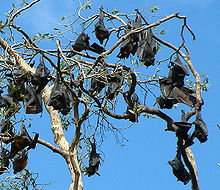Black fruit bat
| Black fruit bat | ||||||||||||
|---|---|---|---|---|---|---|---|---|---|---|---|---|

Black fruit bat ( Pteropus alecto ) |
||||||||||||
| Systematics | ||||||||||||
|
||||||||||||
| Scientific name | ||||||||||||
| Pteropus alecto | ||||||||||||
| Temminck , 1837 |
The black flying fox ( Pteropus alecto ) is a flying fox species from the genus Pteropus within the family of the actual flying foxes (Pteropodidae). It is common in Southeast Asia and Australia .
features
Black fruit bats are one of the larger fruit bats and are Australia's largest bats . They reach a wingspan of over a meter and a weight of 500 to 980 grams. Their fur is predominantly black and there is a reddish mark on the neck. The legs are hairless below the knees, and like most fruit bats, there is no tail. Some animals have a brown eye ring.
Distribution area and habitat
The distribution area of the black fruit bat stretches from the Indonesian islands of Java and Sulawesi to the extreme south of New Guinea and to the north and east coast of Australia . Here they occur from Shark Bay to central New South Wales . Their habitat are bamboo forests , rainforests and mangrove areas , mostly they can be found near the coast.
Lifestyle and diet
Black fruit bats, like most fruit bats, are nocturnal. During the day they sleep in large groups of up to 30,000 animals, and they sometimes share the sleeping places with other types of fruit bats. At sunset they leave their quarters and go in search of food, and they can cover up to 50 kilometers in one night. Their diet consists of nectar, flowers and fruits of various plants such as eucalyptus and myrtle heather . Sometimes they also eat plantation fruits, such as mangoes and figs .
Reproduction
During the mating season, the males secure a small territory of about one meter on a branch, where they present their genitals to the females. The reproductive time is variable depending on the region, in southern Australia most births occur in the months of October to March, in northern Australia in July or August. The individual young animal is first carried by the mother, later placed in a protected place while searching for food. It can accompany you for the first time at two to three months, and around three months later it is independent.
Danger
Since they sometimes invade plantations, black fruit bats are considered a plague and are persecuted. In parts of their range, such as Sulawesi, they are also hunted for their meat. Another threat is the destruction of their habitat. Even so, the species is widespread and common and is not endangered according to the IUCN .
literature
- Ronald M. Nowak: Walker's Mammals of the World . Johns Hopkins University Press, 1999 ISBN 0-8018-5789-9
Web links
- Information at Animal Diversity Web
- Information and photos at arkive.org
- Pteropus alecto onthe IUCN Red List of Threatened Species . Retrieved October 5, 2009.

